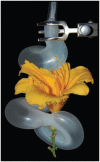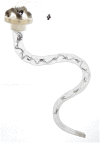Soft Robotics: New Perspectives for Robot Bodyware and Control
- PMID: 25022259
- PMCID: PMC4090912
- DOI: 10.3389/fbioe.2014.00003
Soft Robotics: New Perspectives for Robot Bodyware and Control
Abstract
The remarkable advances of robotics in the last 50 years, which represent an incredible wealth of knowledge, are based on the fundamental assumption that robots are chains of rigid links. The use of soft materials in robotics, driven not only by new scientific paradigms (biomimetics, morphological computation, and others), but also by many applications (biomedical, service, rescue robots, and many more), is going to overcome these basic assumptions and makes the well-known theories and techniques poorly applicable, opening new perspectives for robot design and control. The current examples of soft robots represent a variety of solutions for actuation and control. Though very first steps, they have the potential for a radical technological change. Soft robotics is not just a new direction of technological development, but a novel approach to robotics, unhinging its fundamentals, with the potential to produce a new generation of robots, in the support of humans in our natural environments.
Keywords: biomimetic robotics; biorobotics; morphological computation; smart materials; soft robotics.
Figures
References
-
- Albu-Schäffer A., Eiberger O., Grebenstein M., Haddadin S., Ott C., Wimbock T., et al. (2008). Soft robotics. IEEE Robot. Autom. Mag. 15, 20–3010.1109/MRA.2008.927979 - DOI
-
- Asuni G., Teti G., Laschi C., Guglielmelli E., Dario P. (2006). Extension to end-effector position and orientation control of a learning-based neurocontroller for a humanoid arm. IEEE/RSJ Int. Conf. Intell. Robots Syst. 4151–415610.1109/IROS.2006.281904 - DOI
-
- Boyer F., Porez M., Khalil W. (2006). Macro-continuous computed torque algorithm for a three-dimensional Eel-like robot. IEEE Trans. Robot. 22, 763–77510.1109/TRO.2006.875492 - DOI
-
- Brown E., Rodenberg N., Amend J., Mozeika A., Steltz E., Zakin M. R., et al. (2010). Universal robotic gripper based on the jamming of granular material. Proc. Natl. Acad. Sci. U.S.A. 107, 18809–1881410.1073/pnas.1003250107 - DOI
Publication types
LinkOut - more resources
Full Text Sources
Other Literature Sources



